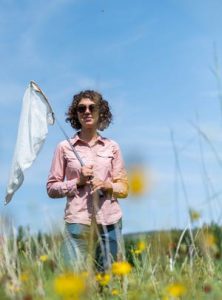Abuzz with native bees: NMSU embarks on a quest to capture bee diversity in New Mexico
Adriana M. Chávez
New Mexico State University
LAS CRUCES – There are more than 4,000 bee species in the United States and about 1,000 bee species in New Mexico due to the state’s diverse landscapes. But native bees aren’t the subject of much research in New Mexico compared to the more well-known honeybee.
Adrienne Rosenberg of New Mexico State University’s Sustainable Agriculture Science Center at Alcalde is working on research to change that.
Currently, Rosenberg is studying the state’s native bee populations by comparing a native wildflower field to an alfalfa field, a more traditional ground-cover and cash crop in New Mexico. By studying the native bee populations in both areas, Rosenberg is measuring the diversity of the bees.
Because of the presence of well-vegetated watersheds fed by acequias, desert landscapes and small farms, northern New Mexico has plenty of unique bee habitats to research, Rosenberg said.
Rosenberg’s project is not only assessing the diversity of bee species in New Mexico, it could also potentially help with the conservation of acequia rights. Rosenberg also hopes to create a demonstration site and establish easy planting methods that may invite native pollinators and help farmers maintain a constant source of pollinators.
“We have a very diverse array of bee species in New Mexico, and one of those reasons is sandy soil is more suitable for solitary nesting bees,” Rosenberg said. “About 70 percent of the bee species are ground-nesting bees.”
Pollinators are part of the sexual reproduction of many flowering plants. More than 75 percent of the Earth’s 115 principal crop species are dependent on or benefit from animal-pollinated crops. Many native flowers in the deserts of the Southwest depend on particular pollinators, as do many food crops.
Rosenberg said honeybees are “kind of the poster child of the perils with bees” but are only one species out of the 4,000 bees in the U.S.
“There’s the expansion of urban areas, which is a big concern, and the aspect of climate change, which causes asynchronous phenology with bloom times and pollination,” Rosenberg said.
Rosenberg hopes her current research project will contribute to a better understanding of bees living in New Mexico and their preferred habitat in northern New Mexico. Rosenberg’s research involves a wildflower plot planted in 2019 and a separate alfalfa plot created from an existing alfalfa field. Both plots receive water from an acequia.
“Often, you can’t control a lot of what happens. You’re at the whim of weather and the seasons,” Rosenberg said. “Fortunately, when COVID hit, I had the support of my colleagues who helped a lot when it came to maintaining the plots.”
Rosenberg hopes her project raises awareness and solutions for New Mexico farmers and landowners in creating habitats for native bees. Her larger vision, she said, is to associate native pollinator habitat restoration with acequia-rights conservation.
To read the complete article go to; NMSU embarks on a quest to capture bee diversity in New Mexico (lcsun-news.com)
For a guide to native bees in New Mexico, visit https://bit.ly/38vNKRD.









